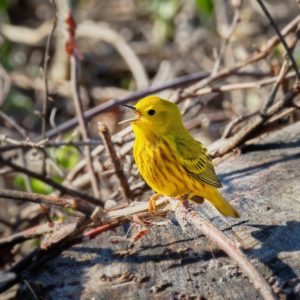
Some of us have spent a large part of our lives enjoying birds in the wild in a practice branded as “birding.” It’s fun to watch for certain kinds of birds, to photograph them, to watch their daily interaction, or simply to have the comfort of birds attracted to a location. While “birding” is an all-encompassing term to identify a hobby, there are specificities that we tend to not recognize as a niche component of birding. One of them is a hobby referred to as “earbirding.”
Earbirding, or birding by ear, is a practice whereby bird lovers work hard to recognize the sound of a specific species without sighting the bird itself. This is often a secondary level to avid birders who have seen all the birds they want and can easily identify them by sight. This new challenge is a more complex one as it requires extreme attentive behavior and extraordinary learning processes to be able to identify a bird specifically – and only – by sound.
Deciphering An Earful of Bird Song
The art of bird song and sound is a maturing process in a birder’s life as they learn to identify what the different sounds produced by a single bird might actually mean. They can tell if a bird’s whistle is calm or concerned. They can identify the mating sounds. Basically, any sound a bird can make for whatever reasons they vocalize them can be understood by the seasoned earbirder. Birds themselves are often mimics and can replicate sounds of others. True earbirders can effortlessly differentiate between the real bird and the mimic just by listening.
Female birds and male birds aren’t just different by their gender and sometimes visual appearance, they often sing differently. Of course, this adds to the complexity of identifying birds by sound. Is it a male cardinal? Or a female cardinal? Who sings more frequently? Do males make a unique sound that females do not? Ask an experienced earbirder. I’m betting you’ll get an earful of information.
As in any market, there are books and recordings, and deep websites that cater to this level of birding attention. One of the premier books on the sounds of birds is the Peterson Field Guide to Bird Sounds. The guide is sold in two volumes that explore the sounds in either Eastern North America or Western North American. Compiled by Nathan Pieplow, the books detail sounds of over 500 North American birds, provides spectrograms (for the truly discriminating and intense participant in earbirding), and offers access to recorded audio on the publisher’s website.
Amazingly, there are downloadable phone apps that can record the sound of an unfamiliar bird and provide a true spectrogram. The spectrogram can then be looked up (one source is the previously mentioned Peterson Field Guide) and matched to known spectrograms from any bird. Instant knowledge! Both iPhones and Android-based phones have access to these apps. Even Alexa (the Amazon hardware tech assistant) can identify more than 2000 bird sounds just by asking. The sounds are pulled from the rich Audubon library by Alexa and replayed for you.
As with regular birding, there are clubs and collectives that gather to discuss the intricacies of bird sounds exclusive of sighting. Many birding clubs offer classes and prepared talks about this specific method of birding.
Birding in any form of enjoyment is a calming experience and a fun hobby. The internet is a rich place to discover all methods, providing information on how to improve in every area.
